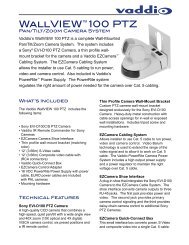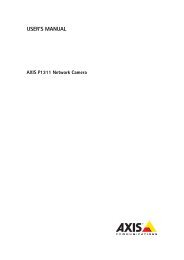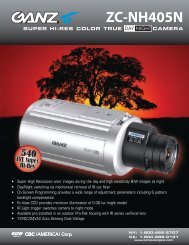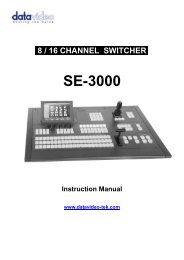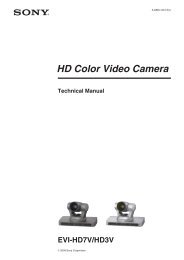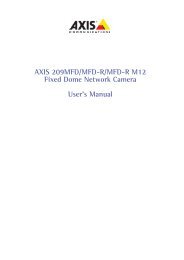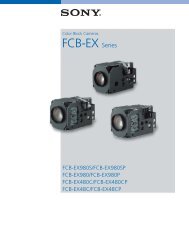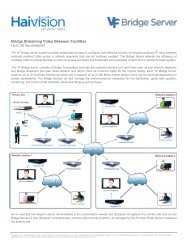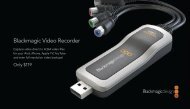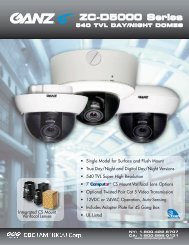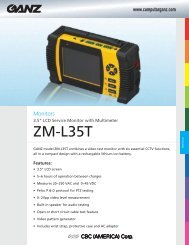AXIS 231D+/232D+ Network Dome Camera User's Manual
AXIS 231D+/232D+ Network Dome Camera User's Manual
AXIS 231D+/232D+ Network Dome Camera User's Manual
Create successful ePaper yourself
Turn your PDF publications into a flip-book with our unique Google optimized e-Paper software.
<strong>AXIS</strong> <strong>231D+</strong>/<strong>232D+</strong> - Glossary of Terms65forms part of the Internet Protocol suite, as defined by theInternet Engineering Task Force. The protocol can supportmonitoring of network-attached devices for any conditionsthat warrant administrative attention.Sockets - Sockets are a method for communication betweena client program and a server program over a network. Asocket is defined as "the endpoint in a connection." Socketsare created and used with a set of programming requests or"function calls" sometimes called the sockets applicationprogramming interface (API).SSL/TSL (Secure Socket Layer/Transport Layer Security)These two protocols (SSL is succeeded by TSL) arecryptographic protocols that provide secure communicationon a network. SSL is commonly used over HTTP to formHTTPS, as used e.g. on the Internet for electronic financialtransactions. SSL uses public key certificates to verify theidentity of the server.Subnet & subnet mask - A subnet is an identifiablyseparate part of an organization's network. Typically, asubnet may represent all the machines at one geographiclocation, in one building, or on the same local area network(LAN). Having an organization's network divided intosubnets allows it to be connected to the Internet with asingle shared network address.The subnet mask is the part of the IP address that tells anetwork router how to find the subnet that the data packetshould be delivered to. Using a subnet mask saves the routerhaving to handle the entire 32-bit IP address; it simply looksat the bits selected by the mask.Switch - A switch is a network device that connectsnetwork segments together, and which selects a path forsending a unit of data to its next destination. In general, aswitch is a simpler and faster mechanism than a router,which requires knowledge about the network and how todetermine the route. Some switches include the routerfunction. See also Router.TCP (Transmission Control Protocol) - TCP is used alongwith the Internet Protocol (IP) to transmit data as packetsbetween computers over the network. While IP takes care ofthe actual packet delivery, TCP keeps track of the individualpackets that the communication (e.g. requested a web pagefile) is divided into, and, when all packets have arrived attheir destination, it reassembles them to re-form thecomplete file.TCP is a connection-oriented protocol, which means that aconnection is established between the two end-points and ismaintained until the data has been successfully exchangedbetween the communicating applications.Telnet - Telnet is a simple method with which to accessanother network device, e.g. a computer. The HTTP protocoland the FTP protocols allow you to request specific filesfrom remote computers, but do not allow you logon as auser of that computer. With Telnet, you log on as a regularuser with whatever privileges you may have been grantedfor specific applications and data residing on that computer.TVL (TV Lines) - A method of defining resolutions inanalog video.UDP (User Datagram Protocol) - UDP is a communicationsprotocol that offers limited service for exchanging data in anetwork that uses the Internet Protocol (IP). UDP is analternative to the Transmission Control Protocol (TCP). Theadvantage of UDP is that it is not required to deliver all dataand may drop network packets when there is e.g. networkcongestion. This is suitable for live video, as there is nopoint in re-transmitting old information that will not bedisplayed anyway.Unicast - Communication between a single sender and asingle receiver over a network. A new connection isestablished for each new user.UPnP TM - A set of computer network protocols that allowsthe automatic peer-to-peer detection of devices on thenetwork. UPnP is promoted by the UPnP Forum.URL (Uniform Resource Locator) - An "address" on thenetwork.USB - (Universal Serial Bus) A plug-and-play interfacebetween a computer and peripheral devices, e.g. scanners,printers.Varifocal lens - A varifocal lens provides a wide range offocal lengths, as opposed to a lens with a fixed focal length,which only provides one.VPN (Virtual Private <strong>Network</strong>) - This creates a secure"tunnel" between the points within the VPN. Only deviceswith the correct "key" will be able to work within the VPN.The VPN network can be within a company LAN (Local Area<strong>Network</strong>), but different sites can also be connected over theInternet in a secure way. One common use for VPN is forconnecting a remote computer to the corporate network, viae.g. a direct phone line or via the Internet.VOP (Video Object Plane) - A VOP is an image frame in anMPEG-4 video stream. There are several types of VOP:- An I-VOP is complete image frame.- A P-VOP codes the differences between images, as long asit is more efficient to do so. Otherwise it codes the wholeimage, which may also be a completely new image.WAN (Wide-Area-<strong>Network</strong>) - Similar to a LAN, but on alarger geographical scale.W-LAN (Wireless LAN) - A wireless LAN is a wireless localarea network that uses radio waves as its carrier: where thenetwork connections for end-users are wireless. The mainnetwork structure usually uses cables.Web server - A Web server is a program, which allowsWeb browsers to retrieve files from computers connected tothe Internet. The Web server listens for requests from Webbrowsers and upon receiving a request for a file sends it



